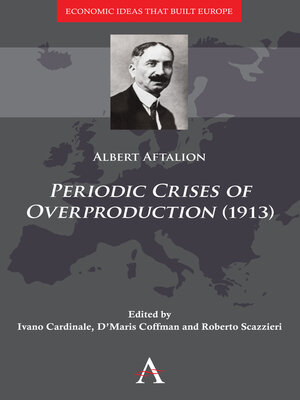
Sign up to save your library
With an OverDrive account, you can save your favorite libraries for at-a-glance information about availability. Find out more about OverDrive accounts.
Find this title in Libby, the library reading app by OverDrive.



Search for a digital library with this title
Title found at these libraries:
| Library Name | Distance |
|---|---|
| Loading... |
The aim of Albert Aftalion's Periodic Crises of Overproduction is to lay the analytical building blocks of a medium-term approach to the theory and policy of economic fluctuations. Aftalion builds his theory on a disaggregated (structural) representation of the economic system that overcomes the conventional micro-macro dichotomy. This analysis eschews both the explanation of crises in terms of cumulative processes triggered by long-term factors and that in terms of purely contingent mismatches and ruptures. Aftalion highlights features such as lack of synchronization between sectors, different time horizons between socio-economic groups, and dissimilar speeds of change between production and consumption units. His approach draws key analytical concepts (such as the accelerator principle) from a detailed investigation of the interdependencies and temporal asymmetries of an industrial economy. It is an enlightening complement to Keynes' General Theory.
|Albert Aftalion's exploration into the theory of periodic, general economic crises in an industrial economy outlines a conceptual framework based upon the distinction between the structural conditions that make a crisis possible and the historical triggers that give any particular crisis its specific character. This distinction is key to Aftalion's theory and policy of the medium term and makes his contribution a forerunner of the principle of contextual emergence in complex dynamics.
This approach allows Aftalion to distinguish between different, but hierarchically related, causal layers: (i) the fundamental relationship between production and needs: capital formation is a necessary condition in order to achieve an equilibrium between production and needs compatible with increasing (or non-diminishing) per capita welfare; (ii) the more historically specific causal layer at which the lengthening of production processes as a result of the increasing utilization of fixed capital items becomes a central feature and makes it necessary to allow for adjustment periods during which the economic system is out of equilibrium and lack of time co-ordination between production and needs may generate crises; (iii) the most specific level of causation at which different institutional arrangements (e.g., private- versus social-ownership economy) determine the response patterns of individuals and groups to the mismatches characterizing out-of-equilibrium situations.
Aftalion's approach highlights causal pluralism in economic dynamics while emphasizing that the different causal triggers are systematically related to one another in a hierarchical way. This intertwining of causal layers is especially relevant in the medium term, which makes the context of medium-term policy decisions the most difficult to detect and, at the same time, of critical importance to the success of policy measures.







